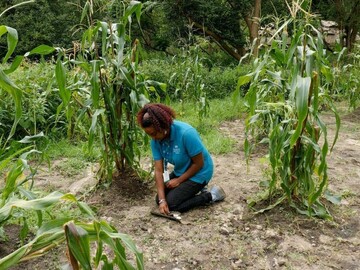Growing Corn, Beans, and Squash in Historic Patuxet
- Date
- 2023
- Author/Maker
- Artist name is no longer known.
- Source
- Plimoth Patuxet Museums

Description
According to Nauset Wampanoag and Penobscot Educator Nancy “Smiling Dove” E. Eldredge (1932-2021):
Around 1,000 years ago, oral history tell us, our relative the Crow flew from the southwest to the Wampanoag nation bringing us the first corn and bean seeds (weachamin gka tuppaquam wskannemuneash) as a gift from the Creator. Since that time, we have learned from our grandmothers and grandfathers how to plant, tend, and harvest these wonderful plants. In ancient times Wampanoag people drew from what they needed from the land without destructive exploitation of the resources. Interacting with the environment was a natural part of the culture… around the time the corn plants were the height of one’s hand, it was time to plant the beans and squashes around the base of the corn. Squashes included pumpkins. Once weachimin grew taller, tuppaquamash climbed and wound around the stalks. Beans, we’ve discovered, add nitrogen to the ground which corn uses up. From this scientific fact from modern times, we clearly see how wisely our grandparents followed the Creator’s instructions for growing these plants…the rhythm of Earth’s cycles, having been adhered to, gave us the delicious bounty of tended foods. For many Wampanoag it is the same today. Our appreciation for all plant life is given to Creator throughout the year as we are nourished once again by these great gifts.1
Each Wampanoag family generally provided food for its members, but there was also a great deal of sharing. Families planted on ground assigned to them, while hunting, fishing and gathering took place on commonly held lands. Since food came from local resources that were shared or assigned, the diet varied little between social levels. In general, everyone in the community ate equally well. Sachems supported widows and the poor, and families gave freely to the sick or elderly.
Wampanoag planting customs and seeds have been passed down for generations. Projects like the Native American Food Sovereignty Alliance’s Indigenous Seed Keepers Network “promote Indigenous cultural diversity for future generations by collecting, growing, and sharing heirloom seeds and plants.”2
The goal of Indigenous Food Sovereignty is “the ability for tribal nations and communities to feed their own people on their own terms.”3 For many Indigenous and First Nations people across the US and Canada, sourcing and consuming traditional foods reaffirm their beliefs that the right to food is a sacred gift and cannot be constrained or restricted by laws, policies, and institutions as well as the fact that they have the right to respond to their own needs for healthy, culturally adapted Indigenous foods.4 Today, traditional heirloom varieties of northern flint corn - such as King Philip Red or White Flint Corn - are being actively reclaimed and cultivated throughout Indigenous homelands. Cassius Spears runs the Narragansett Food Sovereignty Initiative in what is known today as Westerly, Rhode Island. He maintains: “Our traditional agricultural practice is a more knowledge-based conservation approach; we work with the environment. Our traditional ecological knowledge is centered around our conservation practices; one perfect example is in our planting of the three sisters: corn, beans and squash.”5
Discussion Questions
-
Who is responsible for growing corn in Wampanoag families?
-
How were Wampanoag children a part of growing food and taking care of gardens?
-
What are the main crops Wampanoag families still grow in their gardens? Why do you think they are called “companion plants”?
-
Wampanoag families grow a lot of their food in gardens. Where does your food come from? How does it get from where it’s grown to your plate?
-
Think about a garden that you`ve seen at home or in your community. What is growing there? What do those plants tell you about the people who planted them?
- Do you think gardens and farm fields are an important part of your community? Why or why not?
-
According to the English record, it was Tisquantum who taught them to plant corn. Without mentioning of Patuxet women, what might this suggest about how colonists viewed men’s and women’s roles?
Footnotes
- 1Wampanoag: People of the East. 17th-Century Wampanoag Life. Plimoth Plantation Educational Materials, pg. 18
- 2"Indigenous Seed Keepers Network" Native Food Alliance. Accessed 3/28/23.
- 3 "USDA Indigenous Food Sovereignty Initiative”, US Department of Agriculture. Accessed 4/18/23.
- 4 “Indigenous Food Sovereignty,” Indigenous Food Systems Network. Accessed 4/18/23
- 5 Amadeu Finlay, “Eating Indigenous: The Narragansett Food Sovereignty Initiative Focuses on Traditional Agricultural Practice,” Motif. January 16, 2019. Accessed 4/18/23.